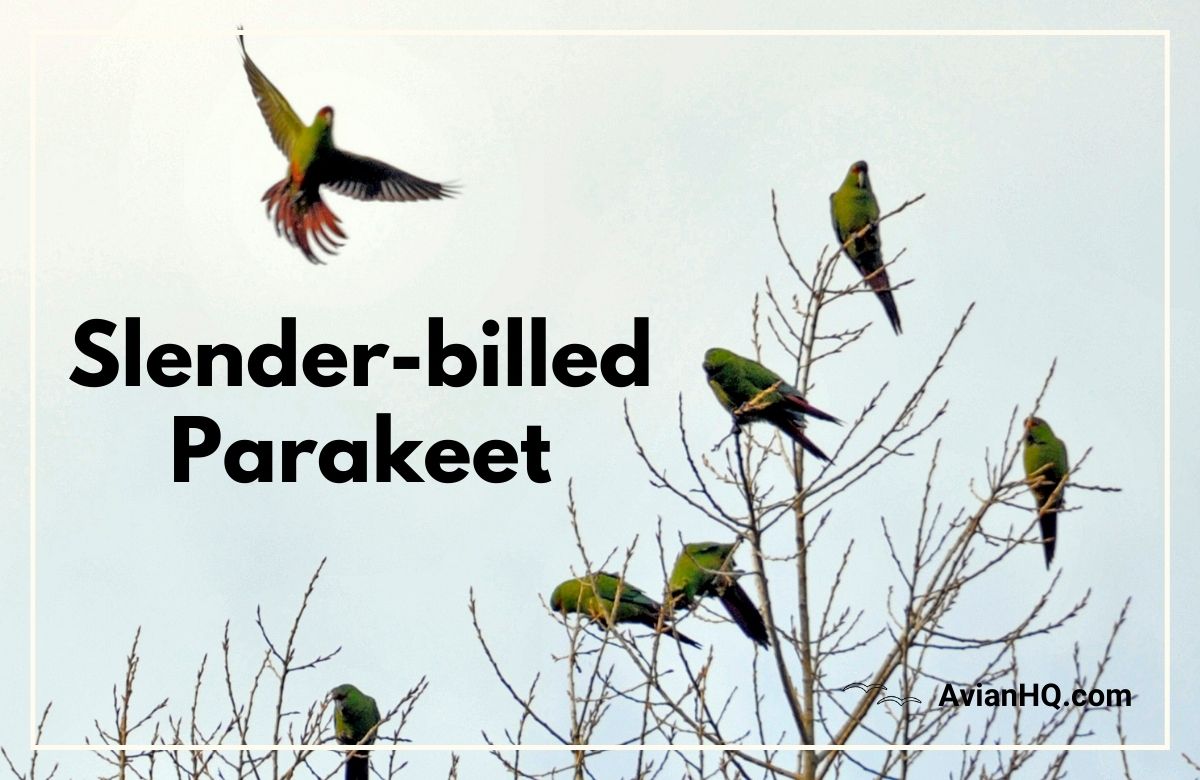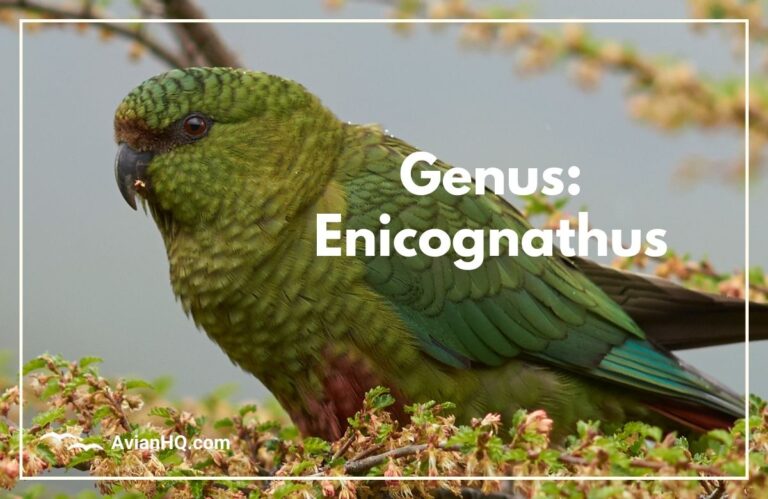Slender-billed Parakeet (Enicognathus leptorhynchus)
You first catch sight of the Slender-billed Parakeet perched high in a tree, blending in with green foliage. Its bright green wings and tail contrast with a paler yellow-green back and head. At just 8 to 9 inches (20 to 23 cm) long, it’s smaller than some parrots but makes up for its size with a large personality.
This parrot’s most noticeable feature is its long, pointed, blue-gray bill used for easily cracking seeds and nuts. The bill gives this bird its name – Slender-billed Parakeet or Long-billed Parakeet. Its scientific name, Enicognathus leptorhynchus, also references the slender bill. Enicognathus means “slender-jawed” while leptorhynchus translates to “slim beak.”
While once abundant, the Slender-billed Parakeet faces threats today across its native range in Chile and Argentina. Land development, logging, fire, and the pet trade contribute to vanishing numbers. However, groups work to study populations and better protect their dry forest and scrubland habitats.
As you read on about this rare South American parakeet, you’ll learn what makes them unique – from the large flocks they travel in to their communal nesting habits. Understanding more about this species can help support conservation efforts so future generations have the chance to see a “slim beak” peeking out from green leaves overhead.
History and Taxonomy
The Slender-billed Parakeet was first described in 1832 by French naturalist René Primevère Lesson, based on a specimen collected near Río Negro, Argentina. He named the new species Psittacus leptorhynchus, recognizing its distinct slim, pointed bill compared to other parrots known at the time.
In the 1800s and early 1900s, the Slender-billed Parakeet was reclassified under various genera including Conurus, Pyrrhura, and Enicognathus, before being returned to its current accepted scientific name Enicognathus leptorhynchus. Recent genetic analysis confirms its placement as the only member of the Enicognathus genus.
While some outdated sources may still use Pyrrhura leptorhyncha, scientists today accept Enicognathus leptorhynchus as the proper binomial nomenclature for this species. This name recognizes the Slender-billed Parakeet’s unique evolutionary lineage and morphological distinctiveness from other parakeet groups. Its common names in English, Spanish, and Portuguese also highlight its thin bill.
Physical Appearance
The most noticeable feature of the Slender-billed Parakeet is of course its long, pointed gray-blue bill that distinguishes the species. The upper bill curves slightly downward over the shorter lower mandible. Their bills range from 0.6 to 0.9 inches (15 to 22 mm) long.
These small parrots reach 8 to 9 inches (20 to 23 cm) in body length. They have a wingspan of about 5.5 to 6 inches (14 to 15 cm). Weight ranges between 1.5 to 2.1 ounces (45 to 60 grams).
Slender-billed Parakeets display green feathers over most of their bodies. Their PRIMARY feathers and long tails are a brighter emerald green. The lower back and much of the head/neck are a paler green with a subtle yellow tint. Some yellow-green scalloping may also appear on the breast.
Unlike some parrot species, males and females have identical plumage. However, mature adults can be visually sexed by color differences in their eyes. Males’ irises are dark brown while the irises of mature females appear whitish or creamy yellow.
Habitat and Distribution
The Slender-billed Parakeet resides in temperate forest and scrubland regions of central Chile and western Argentina. Its habitat consists primarily of thorny shrubland, open woodland dominated by evergreen trees like Winter’s Bark, Chilean Wine Palm, Chilean Hardwood, Luma trees, and Monkey Puzzle trees.
The range extends along a narrow coastal distribution from Coquimbo, Chile south to Chiloé Island, Chile, approximately 560 miles (900 km). It stretches inland to the Andes foothills up to 6,500 feet (2,000 m) elevation. Smaller isolated groups occur in Argentina’s Neuquén and Río Negro provinces.
Though once more widespread, habitat loss has caused population declines and fragmentation. The largest remaining populations today occupy Chile’s Nahuelbuta National Park and the Chilean Coastal Range. However small fragmented groups still exist across suitable habitat between 30°S to 43°S latitude in Chile.
Protecting secondary growth forests and scrublands remains vital for conservation, as these vegetation types host the highest nesting densities. Ensuring connectivity through habitat corridors can also enable dispersal to new areas.
Diet and Feeding
The Slender-billed Parakeet uses its specialized beak to crack open and consume a wide variety of seeds, nuts, berries, fruits, buds, and some insect larvae.
This species forages energetically in the high canopy of trees and scrubs. It uses its agile feet to grasp onto branches and climb through vegetation while feeding. The long pointed bill easily tears into cones and fruits to extract seeds.
Favorite foods include pine nuts, seeds of Winter’s Bark, peumo fruit, Chilean Guava, maqui berries and seeds from Mimosaceae trees like acacias. During breeding season, pairs may chew clay cliffs to obtain minerals. They have also adapted to some exotic fruits introduced to Chile like apples.
Slender-billed Parakeets feed in large, fast-moving flocks that fly from tree to tree. They employ constant chatter and calls to coordinate their social foraging behavior. Most active in early morning and evenings, they may fly long distances of over 6 miles (10 km) daily while alternating feeding and resting periods.
Breeding and Reproduction
The breeding season for Slender-billed Parakeets depends on their geographic location, as southern populations breed earlier in the year. Mating generally takes place from September through January.
These parakeets exhibit unique nesting habits compared to related species. They nest in colonies with nests clustered closely together, rather than solitary pairs. One breeding site study found 58 active nests within a single tree!
Both the male and female participate in choosing a nesting cavity, typically a natural hole or old woodpecker nest in a tree trunk. They may nest between 3 to 65 feet (1 to 20 meters) high. The pair then lines the cavity with sticks and other debris.
The typical clutch contains 3 to 5 white eggs that the female incubates for about 24 days. The male feeds her throughout this period. Once hatched, both parents feed the chicks regurgitated food frequently for about 45 days till they fledge (leave the nest).
Behavior and Ecology
Slender-billed Parakeets exhibit highly social behaviors, moving together in large flocks of 10 to 30+ individuals while traveling and foraging. Some congregations may contain over 100 birds!
They utilize loud screeches, chatter, and contact calls to coordinate actions and movements as a group. Flocks fly swiftly between sources of food and roosting sites, alternating feeding bursts with periods of rest throughout the day. Peak activity occurs early morning and late afternoon.
This species sleeps communally, gathering into dense roosting flocks at night for safety from predators. Though agile fliers, they remain vulnerable to attack from native forest raptors like the Chilean Hawk and Black-chested Buzzard-Eagle who hunt from below the canopy. Introduced mammals also pose threats.
To guard nest sites, groups mob potential predators with loud alarm calls and dive attacks. They exhibit strong site fidelity, returning to the same nesting colonies year after year. Pairs preen each other frequently and may remain bonded for multiple seasons.
Conservation Status
The Slender-billed Parakeet has a restricted range and suffers from ongoing habitat destruction, causing its numbers to decline. It is currently classified as Endangered on the IUCN Red List.
While never abundant, past estimates put its global population size around 20,000 to 50,000 mature individuals in the 1990s. However, habitat loss and fragmentation of Chilean temperate forests mean current populations likely number under 10,000 total remaining birds.
Specific threats come from logging, land conversion for agriculture, wildfires, mining, infrastructure development, and the pet trade. For example, over 5,000 km2 of scrubland habitat has been lost just in Chile’s central valley since 1985. Without improved protection, extinction may occur within decades.
Conservation groups like the World Parrot Trust fund research and community education programs to support habitat protection for the Slender-billed Parakeet. Captive breeding initiatives and nest box provisioning also help recovery efforts, though preventing further habitat destruction remains the greatest need.
Cultural Significance
The brilliant green plumage and gregarious habits of Slender-billed Parakeets have made them popular as pets in Chile and internationally. However, thousands are still illegally captured from the wild each year for the pet trade.
These parakeets appear occasionally in the folk art and poetry of central Chile and areas where they naturally occur. Some Mapuche tribe stories reference the noisy flocks that descend on nut-bearing trees.
Early European explorers took note of the long slender bills that gave these parakeets their common name. Charles Darwin observed them during his voyage to South America and collected specimens.
Unfortunately, the pet trade and anthropogenic habitat destruction now threaten the species’ cultural legacy. Most Chileans have never seen groups of 100 or more Slender-billed Parakeets descend on a fruiting tree. Protecting remaining populations ensures future generations experience this iconic sight.
Eco-tourism relies on their presence as well. Birders travel from worldwide to southern Chile’s forests hoping to glimpse the swift-flying parakeet flocks in natural settings. Saving the habitat of this Endangered species also conserves the area’s biodiversity.
Conclusion
The Slender-billed Parakeet stands out for its pointed blue-gray bill and bright green plumage, but also for its highly social behavior moving in large swift flocks. This species remains culturally significant and attracts interest from birders worldwide.
However, habitat destruction has caused substantial population declines over the past decades. Logging, agriculture, wildfires, urbanization, and the pet trade continue threatening its limited Chilean forest ecosystem.
Only an estimated global population under 10,000 individuals remains. But protecting secondary scrublands and woodlands can help the Endangered Slender-billed Parakeet rebound. Initiatives like nest boxes, better regulations, and community engagement also improve ongoing conservation.
Though small, the parakeet serves as an indicator species for the temperate forest habitat on which many other plants and animals depend. Saving these vanishing forests remains key to preserving Chile’s natural heritage and ensures the “slim beak’s” chatter and sightings persist for generations to come.



